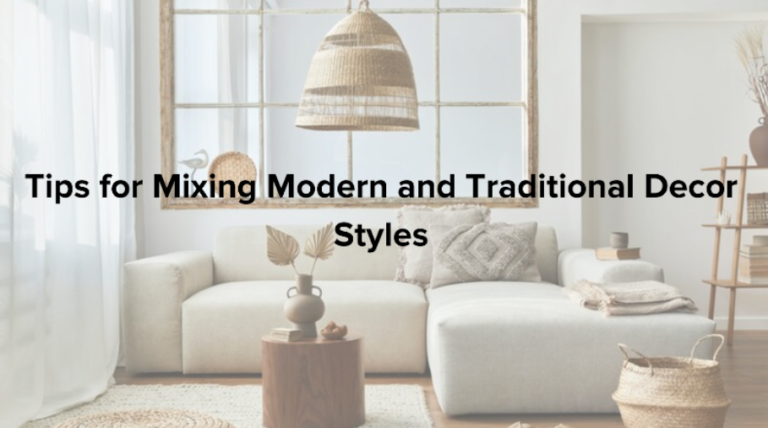Do you love the sleek lines and contemporary flair of modern design but also appreciate the warmth and character of traditional styles? Blending modern and traditional decor styles creates a unique and visually appealing interior space that reflects your personal taste and style.
However, achieving the perfect balance between these two contrasting aesthetics can be challenging. In this blog post, we’ll explore tips and strategies for seamlessly blending modern and traditional decor styles, creating a harmonious and visually captivating living space that reflects your unique taste.
Whether you’re starting from scratch or revamping an existing space, these insights will guide you in curating a personalized and inviting interior that strikes the perfect balance.
Furniture and Accessories
When blending modern and traditional styles through furniture and accessories, it’s essential to strike a balance between clean lines and ornate details. Start by selecting a few key pieces that anchor each aesthetic, such as a minimalist sofa or a stately armchair with intricate wood carvings.
From there, layer in complementary pieces that bridge the two styles, like a sleek coffee table paired with an antique area rug. For those looking to find such pieces, visiting a living room furniture store can provide a wide variety of options.
Play with Scale and Proportion
When mixing modern and traditional decor styles, pay attention to scale and proportion. Balance oversized, modern pieces with smaller, more delicate traditional accents, or vice versa. If you are arranging furniture for living rooms, a large, minimalist sectional sofa could be paired with a petite, ornate side table.
When placing furniture in your study room, a sleek, contemporary lamp could be placed next to a traditional, intricately carved armchair. This approach ensures the different elements complement each other, creating a harmonious and aesthetically pleasing space.
Invest in Statement Pieces
When mixing modern and traditional decor styles, invest in a few statement pieces that serve as focal points in the room. For example, pair a traditional, ornately carved wooden armchair with a sleek, modern glass coffee table, or juxtapose a classic, tufted sofa with a contemporary metal and glass side table. If you’re seeking inspiration, consider exploring living room furniture ideas online or in showrooms.
Incorporate Antiques and Vintage Finds
Incorporating antiques and vintage finds can add character and depth to a modern space. Scour flea markets, antique shops, and online marketplaces for unique pieces that can be seamlessly integrated into your decor. An ornate mirror, a vintage trunk repurposed as a coffee table, or a classic chandelier can instantly add a sense of history and tradition to a contemporary setting.
Establish a Cohesive Color Palette
Choosing the right color palette is key to creating a seamless fusion of modern and traditional aesthetics. Neutral base colors like whites, beiges, and grays provide a versatile foundation that allows both styles to shine. These soft, calming tones prevent the space from feeling too busy or overwhelming.
From there, you can layer in accent colors that speak to each style. For the modern side, consider bold, saturated hues like teal blues, mustard yellows, or vibrant corals. These eye-catching colors add energy and vibrancy.
Balance them out with traditional accent colors pulled from nature like warm terracotta reds, deep forest greens, or rich plum purples. This refined palette evokes a sense of history and elegance.
The interplay of these complementary color stories is what allows the two aesthetics to meld seamlessly. The vibrant modern tones are grounded by the traditional hues, while the classic colors are livened up by the contemporary accents. Using this palette in textiles, artwork, and decor accents creates a cohesive, purposeful look.
Mix Textures and Materials
Incorporating diverse textures and materials is just as crucial as curating a cohesive color palette when blending modern and traditional styles. This layered, tactile approach prevents the space from feeling flat or one-dimensional. By juxtaposing contrasting surfaces and textiles, you create visual and tactile interest, allowing the two aesthetics to harmoniously coexist.
On the modern side, use sleek materials like polished metallics, lacquered wood pieces, smooth concrete accents, and crisp linen or cotton upholstery. These streamlined elements provide a minimalist foundation.
Then, counterbalance them with traditional textural elements, such as intricately carved wood furnishings, plush velvet or brocade fabrics, sumptuous area rugs with visible texture, and nubby wool or faux fur accents.
The key is finding the right balance and thoughtful distribution of these varied surfaces throughout the space. By blending materials and textures, you add both visual and tactile depth, where the modern pieces provide a clean, crisp foundation, while the layered traditional accents soften the space with luxurious warmth and patina. With the right mix, the two styles enhance one another rather than compete.
Architectural Elements
Architectural elements can significantly influence the overall aesthetic, so it’s crucial to consider them when merging modern and traditional styles. If you’re working with existing architectural features like exposed wooden beams or detailed moldings, embrace them as focal points and complement them with modern accents like clean-lined built-ins or a contemporary fireplace surround.
Embrace Contrast with Exposed Beams or Brick Walls
Exposed beams or brick walls add warmth and character to a space, providing the perfect backdrop for mixing modern and traditional decor styles. Contrast these rustic architectural elements with sleek, contemporary furniture and accessories for a striking juxtaposition.
Incorporate Architectural Salvage
Architectural salvage pieces like reclaimed wood beams, vintage doors, or antique fireplace mantels can seamlessly blend modern and traditional styles. Repurpose these unique finds as statement pieces or incorporate them into your decor to add history and character.
Experiment with Lighting
Lighting can play a crucial role in tying together modern and traditional decor styles. Consider incorporating a combination of modern and traditional lighting fixtures, such as a sleek contemporary pendant light paired with a classic crystal chandelier. This blend of lighting styles creates a visually appealing contrast and adds depth to the space.
| Modern Elements | Traditional Elements |
| Clean lines | Ornate details |
| Sleek materials (metal, glass, concrete) | Warm materials (wood, velvet, natural fibers) |
| Minimalist aesthetic | Intricate patterns and carvings |
| Geometric shapes | Curved, organic shapes |
| Bold, saturated colors | Muted, earthy tones |
Conclusion
Mixing modern and traditional decor styles is an art form that requires careful consideration and a keen eye for balance and harmony. By following these tips and embracing contrasting elements, you can create a unique and visually stunning living environment that reflects your personal style and taste. Remember, the key is to experiment, have fun, and trust your instincts to create a space that truly resonates with you.
Frequently Asked Questions
Can I mix modern and traditional patterns?
Patterns are a great way to blend these styles. Pair a modern geometric print with a traditional floral or damask pattern, but use them sparingly to avoid a busy look.
What if I prefer one style over the other?
You can still incorporate elements of both styles, but allow your preferred aesthetic to take the lead, with the other style playing a supporting role.
Is it okay to mix different wood tones?
Yes, mixing wood tones can add depth and interest to your space. Just be sure to balance them with consistent accents and a unifying color scheme.
Key Takeaways
- Establish a cohesive color palette to unify the styles.
- Mix textures and materials to create visual interest and depth.
- Invest in statement pieces that blend the styles seamlessly.
- Embrace architectural elements like exposed beams or brick walls.
- Experiment with lighting to create contrast and ambiance.





